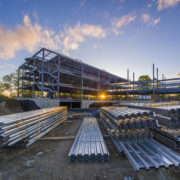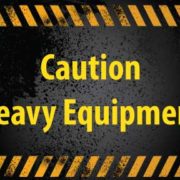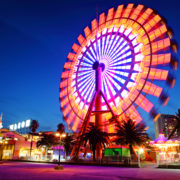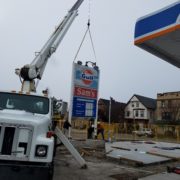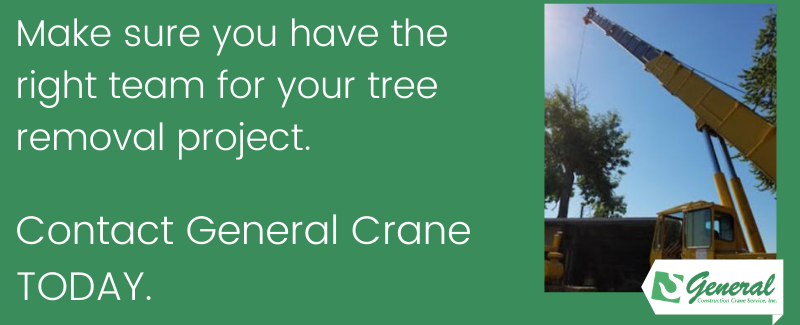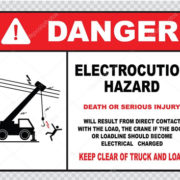The Three Biggest Dangers When Moving Steel
Crane Construction Services, Crane SafetyErecting and moving heavy materials can be a matter of life and death.
No matter the job, big or small, every construction site presents its own challenges and dangers. But when it comes to moving heavy materials, the cost of a mistake can be a serious injury or even death. Having an experienced professional crane operator is vital for the safety of both the crew and everyone else on or near the worksite. Make sure your operator is well-versed in handling each of these three critical areas.
Load management
A crane operator must be well aware of the capabilities of the equipment he or she is using. Attempting to lift a load that is too heavy for the equipment can lead to a catastrophic accident, including the tipping of the crane. Additionally, the operator must understand load balance and how weather conditions might affect the lift. You’ve probably seen video footage of the nightmare scenario when a steel girder goes slightly off balance or gets caught in a gust of wind. The shifting weight can lead the girder to spin like a helicopter blade! An experienced operator, coupled with the right equipment for the job, will minimize the risk of accidents like these.
Falling
Naturally, one of the worst things that can happen when a crane is lifting any materials is for the load to fall. At the very least, it causes financial loss because of the damage to the material and to whatever it lands on—but you know that the risk to human life is much greater than that.
Always ensure that your crane provider utilizes properly maintained equipment that is regularly load-tested. You also need an operator who understands how to secure all shapes and sizes of heavy loads. Ask questions, and make sure you are working with a company with a full understanding of proper load handling.
Electrical hazards
The load isn’t the only thing that must be considered when utilizing a crane. Obstacles on the job site must be planned around, as well—and among the most dangerous obstacles are high-voltage power lines. If any metal part of a crane (or the load on a crane) comes in contact with a power line, it can kill not only the operator but also multiple people in the vicinity of the crane.
Analyzing a site before beginning a job and creating a safe plan is crucial. Make sure you are working with a company with experience planning for a variety of site layouts and obstructions, and get a clear understanding of the plan before the job even begins.
Safe lifts can be accomplished with the right equipment and the right operators. General Crane’s team will work with site engineers and general contractors to come up with the right plan, and our operators will provide the necessary hands-on experience to help keep everyone safe on the job site.
So … what’s your plan?
Crane Construction Services, Crane SafetyTo move heavy, expensive materials and machines, you need to get the strategy right first.
Every construction site presents unique challenges. Materials are often awkward, heavy, and expensive—and contractors need to have a strategy for moving and lifting to keep both the materials and the workers safe.
A successful strategy involves both the right equipment and the right operators. At General Crane, our team has the experience to recommend the best methods for moving and staging even the most cumbersome building materials. It all starts with good planning.
Our planners will work hand-in-hand with site engineers and general contractors, as well as skilled tradesmen, to come up with the right equipment and lifting methods for each job. Will heavy loads have to be lifted into awkward or difficult spaces? How will the transportation of the materials affect public walkways and common areas? Could power, water, or gas lines be compromised?
These are the things that must be considered before equipment can start moving heavy materials on site. Planning like this not only helps save money and prevent loss or downtime, it can absolutely help safeguard the well-being of people on the site (both workers and civilians).
The right crane, coupled with a properly qualified operator, can move and place heavy materials and items quickly and efficiently. Stacking, lifting, storing, moving—there are a wide variety of cranes available, and we have the expertise to match the right equipment and the right operator to your job.
The next time you need a crane to move something on a construction job, consult with us first. We’ll assess your project and come up with the right strategy to protect your materials, keep your crew safe, and increase your productivity.
Bringing Thrill Rides to Life Takes Expertise
Crane Construction Services, Crane SafetyThe Big E trusts General Crane to help construct their exciting Midway rides
If you’ve lived in southern New England for even a year or two, you know about the Big E. It’s an enormous 17-day exposition held in West Springfield, Massachusetts, that begins each year on the second Friday after Labor Day. It is basically a gigantic “state fair” that encompasses not only Massachusetts, but also Connecticut, Rhode Island, Vermont, New Hampshire, and Maine. You can tour the Avenue of States to enjoy the amazing food and attractions from each of the participants, and then try your luck on one of the Midway games or take in a concert from a top named artist.
And then there are the rides! You can soar through the air on the Yo Yo or the Cliff Hanger, or enjoy a breathtaking view atop the Giant Wheel. The Big E features dozens of thrilling rides that, unlike a permanent amusement park, must be assembled at the site and then removed at the end of the fair. Have you ever thought about HOW they manage to get that done?
Cranes play a huge part in the process, and The Big E trusts General Crane to provide the equipment and expertise. Each ride has unique height and weight specs, and General Crane partners with the expo’s planners to make sure the right crane (and crane operator) are assigned to each project.
We’re proud to be selected by an organization like the Big E. Nothing is more important than the safety of their attendees, and that safety begins with the proper assembly of the rides. General Crane brings the equipment and the knowledge to help make that happen!
Choosing the Right Crane Company for Your Sign Installation
Crane Construction Services, Crane SafetyIt’s that time of year to make sure your stockings are hung with care, in hopes that Saint Nick will pay you a visit. Just like those stockings, it’s important to hang your signage with care so that your customers can see you and stop in. High quality signage can be a significant cost for any business. Most are willing to make the investment because the return is great. What they must take into consideration is how to get the sign hung properly. There is lots to consider when determining how to install your sign.

Many of the larger sign producers have small boom or sign trucks but that might not be the ideal solution for a larger sign. You need to have the right equipment to ensure the signage is put up properly and stays there. Crane rental saves money in the long run to ensure the sign is hung with no problems.
The main consideration is safety, for any of the people involved in hanging the sign. To help ensure this, you need to first make sure that the sign is rigged properly when putting it in place. It should also have a tag line on it to control the sign. This will also help to avoid the effect of wind. The greater the surface of the sign, the greater the possibility for swing. An experienced team will take these things into consideration.
This process holds true for a variety of sign products from site and neon, LED signs or digital signs. Regardless of the type of sign, it needs to be hung with care. When determining how to install your sign, consider hiring a professional crane operator to do the job safely and efficiently.
Contact Us at 860-528-8252 for your sign needs.
The Complexity of Tree Work When a Crane is Needed
Crane Construction Services, Crane SafetyRemoving trees from a property can be tricky. Using a crane to do the work adds an additional layer of complexity. That is why it’s imperative to hire the right crane operators for the job.
In addition to being licensed, experienced and professional, there are other requirements for crane assisted tree removal.
The tree expert needs to be an expert on the type of trees being removed.
It’s imperative that the crane operator understands the weight of the trees they’re working with. Obviously an oak weighs more than a birch, but what does that mean as it relates to removal?
We recently worked with a tree guy who could tell us the weight of each cut piece to within a hundred pounds. The project went smoothly because the ground crew was prepared to tell us the job specifications. We then did not have to constantly adjust the crane once the log was picked up. The expertise of the tree expert saved the client time and money when removing trees.
The crane operator needs to be experienced.
Often tree work requires the crane operator to do work that is not in the line of sight. This can be very challenging for someone who does not have experience in crane assisted tree removal.
They also need to understand how the weight and shape of each log will affect the process. Worst case scenario, underestimating the weight could lead to tipping the crane, or overestimating the weight cold lead to dropping the log where you don’t want it to fall. Our highly skilled operators go through extensive training to prepare them for these scenarios, saving the client’s bottom line.
It’s that time of year when property managers need to address their tree needs. Before the winter storms with snow and wind, they need to get the unhealthy trees cut and removed. Make sure you choose the right team to do it for you. Contact General Crane or give us a call today.
Crane Operations Require Experience to Ensure Safety
Crane Construction Services, Crane SafetyAccording to OSHA’s analysis of crane accidents, there are an average of 71 fatalities each year. That accounts for almost 10% of all construction worker deaths.
Crane accidents happen more often than the average person would think. News media does not put these accidents on TV and they don’t make major headlines. The first alarm to the construction community was when six construction workers died and 24 were injured in a NYC crane collapse back in March 2008. Then 10 days later, a 20-foot crane section in Miami fell 30 stories, killing two construction workers and injuring five.
Even though regulations and guidelines have become stricter, crane accidents still happen every year. In 2016, a crane operator and a construction worker were killed when a steel beam fell from a crane on a windy day in Queens, NY. According to the NY Times, “the beam had been lifted about four stories when it fell, striking the cab of the crane and killing the operator inside before hitting the worker on the ground who had been helping to guide it with a flag.” Two workers in their 40’s were dead before emergency workers arrived at the scene. According to officials the 650lb beam fell due to failure of the crane’s rigging. Earlier that year, the mayor temporarily tightened the rules for cranes operating in high winds after a crane fell in Manhattan, killing one person and injuring three others.
In past posts we’ve talked about experience being at the heart of getting the job done in a timely and cost effective manner. Experience is critical when it comes to safety. At General Crane, all our operators have passed the CT Crane Licensing Test and with over 100 years of combined experience, we work with our clients on a consultative basis. Most organizations measure being accident free in days and months, at General Crane, we measure our accident free in years. Since opening in 1972, we have proudly remained accident free. From project estimation to alternative recommendations, General Crane will ensure the job gets done in the most efficient, safest and cost-effective manner.

Address & Phone
Phone (860) 528-8252
Latest Posts
Serving Connecticut, Massachusetts and Rhode Island
Centrally located in Hartford county, they work in Hartford, New Haven, Middlesex, Fairfield, Windham and Litchfield counties as well as neighboring states.
All of our cranes and equipment are 3rd Party Certified annually by:



